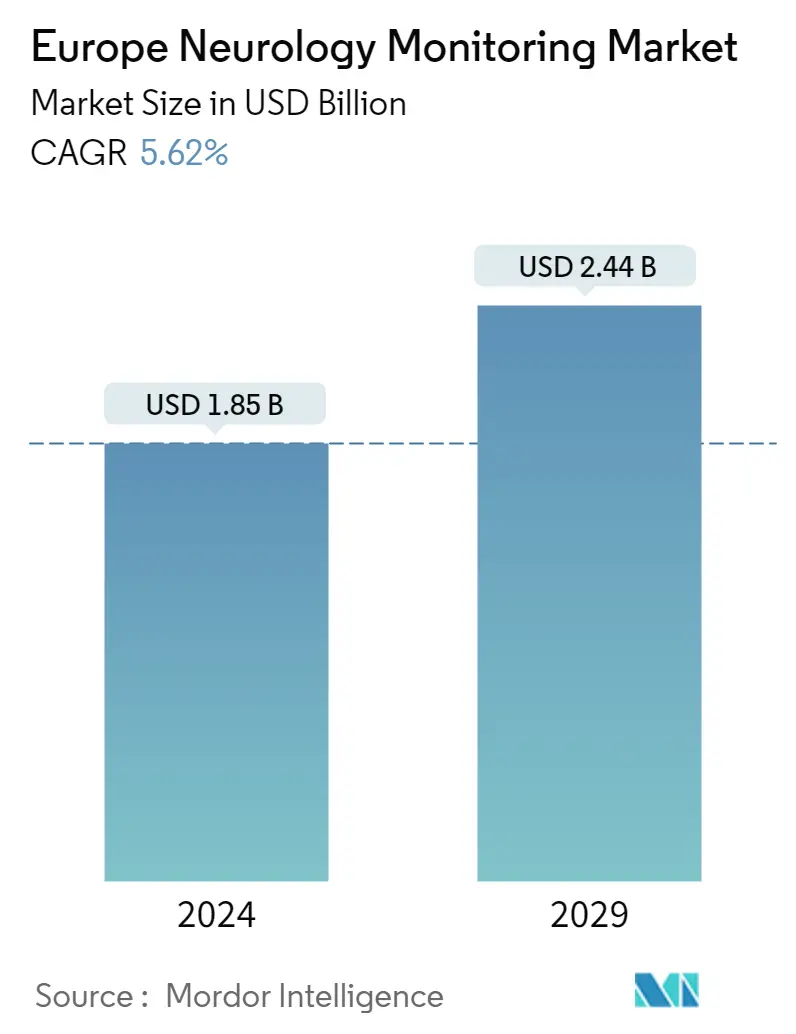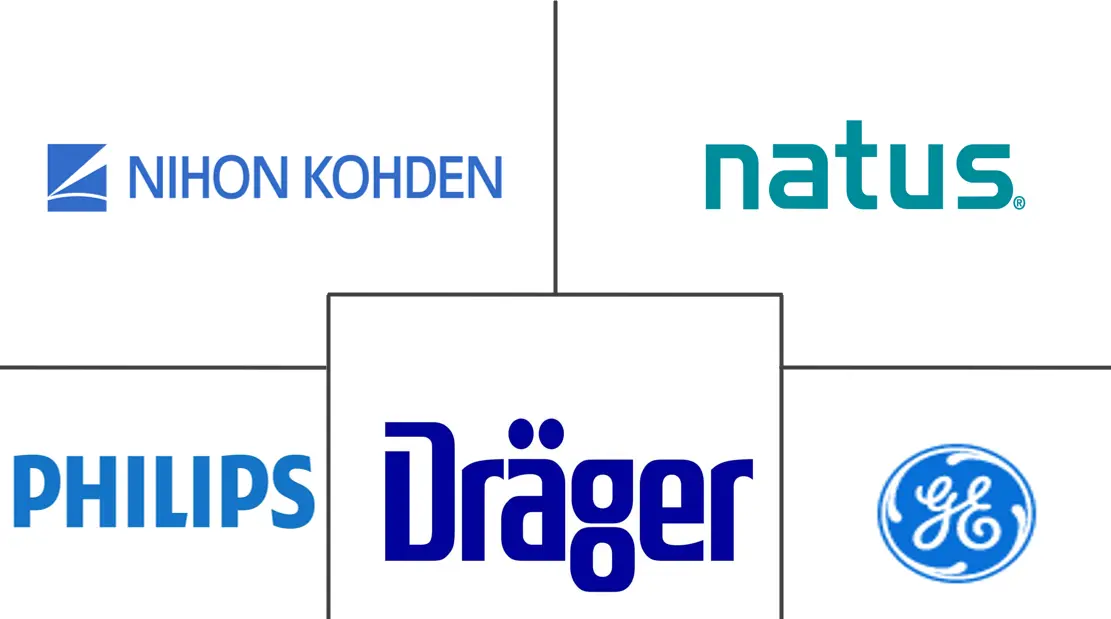Market Size of Europe Neurology Monitoring Industry

| Study Period | 2019 - 2029 |
| Base Year For Estimation | 2023 |
| Forecast Data Period | 2024 - 2029 |
| Market Size (2024) | USD 1.85 Billion |
| Market Size (2029) | USD 2.44 Billion |
| CAGR (2024 - 2029) | 5.62 % |
Major Players
*Disclaimer: Major Players sorted in no particular order |
Europe Neurology Monitoring Market Analysis
The Europe Neurology Monitoring Market size is estimated at USD 1.85 billion in 2024, and is expected to reach USD 2.44 billion by 2029, growing at a CAGR of 5.62% during the forecast period (2024-2029).
The lockdown and government regulations imposed due to the pandemic led to the cancellation and rescheduling of neurologic surgeries that have impacted Europe's neurology monitoring market. For instance, an article published in the journal J. Neurol. Sci in January 2021, reported that data from Spain showed that 95% of hospitals reallocated neurologists to assist COVID-19 patients, and the number of beds in neurology wards was reduced by 89%. The pandemic has exposed the lack of sufficient health care for patients with mental illnesses in many European countries, particularly in locations where hospital-community integration is already lacking. The shift in health resources for COVID-19 patients, along with social distancing measures, has put neurological monitoring in jeopardy in Europe not just in the outpatient context but also in inpatient and home care settings. Thus, initially, the market growth of the market was impacted due to the cancellation of many neurosurgical surgeries. This decreased the demand for neurological monitoring devices. However, with the resumption of services, the market is expected to witness significant growth during the forecast period.
The key factors propelling the growth of the European neurology monitoring market are the increasing incidence of neurological disorders, huge investments by private players in neurology monitoring devices, an increase in R&D in the field of Neurotherapy, and a rising aging population. The growth of the neurology monitoring devices market in Europe is also attributed to the increasing incidence of neurological disorders that include brain aneurysms, brain tumors, epilepsy, memory disorders, multiple sclerosis, Parkinson's disease, peripheral neuropathy, post-herpetic neuralgia, spinal cord tumors, and stroke.
An article published in the journal Cells in August 2022 reported that brain disorders represent 32% of the global disease burden, with 169 million Europeans affected. Neurological disorders, brain and CNS cancers, strokes, and mental disorders are all examples of brain disorders. The high toll on the life quality of patients suffering from neurodegenerative diseases and the societal burden that is growing with the aging of the western population. Thus, increasing brain disorders demand increasing neurological monitoring devices in the region, thereby contributing to the growth of the studied market.
Similarly, the data published by Eurostat in February 2022 reported that more than one-fifth (20.8%) of Europe's citizens were 65 years of age or older in 2021. Between 2021 and 2100, there may be a projected 2.5-fold increase in the proportion of individuals in Europe who are 80 years or older, from 6.0 to 14.6%. As the number of the elderly population is expected to rise, they will be more prone to chronic conditions such as neurological diseases and other brain disorders, which will drive demand for neurological monitoring devices and ultimately drive the market during the forecast period.
The launch of products by market players is also propelling the growth of the market. For instance, in May 2021, Grosshansdorf, a Germany-based neo-scan solution, released a small, light MRI scanner designed to keep journeys short and to scan sick babies in their sleep.
Thus, due to the aforesaid mentioned reasons the region is expected to witness significant growth during the forecast period. However, the high cost of equipment and shortage of trained professionals may slow down the growth of the market studied.
Europe Neurology Monitoring Industry Segmentation
Neurology monitoring devices are used to monitor and diagnose neurological conditions by exploring the structure and function of the brain. This process involves the use of several brain-tracking devices to track and measure brain functions. In addition, these devices help monitor neural and electrical activity in the brain.
The European neurology monitoring market is segmented by product type (magnetic resonance imaging (MRI) devices, electroencephalography devices, cerebral oximeters, intracranial pressure monitors, and other product types), disease (traumatic brain injury (TBI), stroke, sleep disorders, Parkinson's disease, epilepsy, and other diseases) and geography (Germany, United Kingdom, France, Italy, Spain, and the Rest of Europe). The report offers market size and forecasts in value (USD million) for the above segments.
| By Product | |
| Magnetic Resonance Imaging (MRI) Devices | |
| Electroencephalography Devices | |
| Cerebral Oximeters | |
| Intracranial Pressure Monitors | |
| Other Products |
| By Disease | |
| Traumatic Brain Injury (TBI) | |
| Stroke | |
| Sleep Disorders | |
| Parkinson's Disease | |
| Epilepsy | |
| Other Diseases |
| Geography | |
| Germany | |
| United Kingdom | |
| France | |
| Italy | |
| Spain | |
| Rest of Europe |
Europe Neurology Monitoring Market Size Summary
The European neurology monitoring market is poised for significant growth over the forecast period, driven by an increasing incidence of neurological disorders and a rising aging population. The market experienced initial setbacks due to the COVID-19 pandemic, which led to the cancellation and rescheduling of neurologic surgeries, thereby impacting the demand for monitoring devices. However, as services resume, the market is expected to expand, supported by substantial investments from private players and advancements in neurotherapy research. The prevalence of conditions such as Parkinson's disease, epilepsy, and brain tumors, coupled with the aging demographic, is fueling the demand for neurology monitoring devices across the region. Technological advancements, including the development of innovative MRI systems and wearable sensor devices, are further propelling market growth.
Germany is anticipated to be a key contributor to the market's expansion, driven by its high geriatric population and the prevalence of brain disorders. The country is witnessing a surge in the development and launch of new neurology monitoring devices, supported by technological advancements from major market players. The increasing incidence of traumatic brain injuries also necessitates the use of these devices, thereby boosting market growth. The competitive landscape in Europe is characterized by the presence of both international and local companies, with ongoing product launches and regulatory approvals enhancing the market's growth prospects. Despite challenges such as high equipment costs and a shortage of trained professionals, the market is expected to thrive, driven by the growing need for effective neurological monitoring solutions.
Europe Neurology Monitoring Market Size - Table of Contents
-
1. MARKET DYNAMICS
-
1.1 Market Overview
-
1.2 Market Drivers
-
1.2.1 Increase in Incidence of Neurological Disorders
-
1.2.2 Growing Incidence of Traumatic Brain Injuries
-
1.2.3 Rise in the Aging Population
-
-
1.3 Market Restraints
-
1.3.1 High Cost of Equipment
-
1.3.2 Shortage of Trained Professionals
-
-
1.4 Porter's Five Force Analysis
-
1.4.1 Threat of New Entrants
-
1.4.2 Bargaining Power of Buyers/Consumers
-
1.4.3 Bargaining Power of Suppliers
-
1.4.4 Threat of Substitute Products
-
1.4.5 Intensity of Competitive Rivalry
-
-
-
2. MARKET SEGMENTATION (Market Size by Value - USD million)
-
2.1 By Product
-
2.1.1 Magnetic Resonance Imaging (MRI) Devices
-
2.1.2 Electroencephalography Devices
-
2.1.3 Cerebral Oximeters
-
2.1.4 Intracranial Pressure Monitors
-
2.1.5 Other Products
-
-
2.2 By Disease
-
2.2.1 Traumatic Brain Injury (TBI)
-
2.2.2 Stroke
-
2.2.3 Sleep Disorders
-
2.2.4 Parkinson's Disease
-
2.2.5 Epilepsy
-
2.2.6 Other Diseases
-
-
2.3 Geography
-
2.3.1 Germany
-
2.3.2 United Kingdom
-
2.3.3 France
-
2.3.4 Italy
-
2.3.5 Spain
-
2.3.6 Rest of Europe
-
-
Europe Neurology Monitoring Market Size FAQs
How big is the Europe Neurology Monitoring Market?
The Europe Neurology Monitoring Market size is expected to reach USD 1.85 billion in 2024 and grow at a CAGR of 5.62% to reach USD 2.44 billion by 2029.
What is the current Europe Neurology Monitoring Market size?
In 2024, the Europe Neurology Monitoring Market size is expected to reach USD 1.85 billion.

